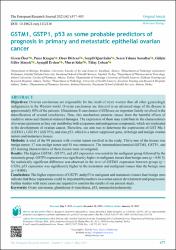GSTM1, GSTP1, p53 as some probable predictors of prognosis in primary and metastatic epithelial ovarian cancer

Göster/
Tarih
2023Yazar
Özer, GizemKaygın, Pınar
Dirican, Onur
Oğuztüzün, Serpil
Yılmaz Sarıaltın, Sezen
Şimşek, Gülçin Güler
Erdem, Ayşegül
Kılıç, Murat
Çoban, Tülay
Üst veri
Tüm öğe kaydını gösterÖzet
Objectives: Ovarian carcinomas are responsible for the death of more women than all other gynecologic
malignancies in the Western world. Ovarian carcinomas are detected in an advanced stage of the disease in
approximately 80% of the patients. Glutathione S-transferases (GSTs) are an important family involved in the
detoxification of several xenobiotics. Thus, this mechanism protects tissues from the harmful effects of
oxidative stress and chemical-induced damages. The expression of them may contribute to the characteristics
of ovarian carcinoma as they can metabolise both exogenous and endogenous compounds, which are implicated
in the development of ovarian cancer. Therefore, our aim was to determine the expressions of GST Mu 1
(GSTM1), GST Pi 1 (GSTP1), and also p53, which is a tumor suppressor gene, in benign and malign ovarian
tumors and metastasis tissues.
Methods: A total of the 99 patients with ovarian tumor enrolled in the study. Thirty-one of the tissues was
benign tumor, 17 was malign tumor and 51 was metastasis. The immunohistochemical GSTM1, GSTP1, and
p53 staining characteristics of these tissues were investigated.
Results: The highest GSTM1, GSTP1, and p53 expression was noted in the malignant group followed by the
metastasis group. GSTP1 expression was significantly higher in malignant tissues than benign ones (p = 0.015).
No statistically significant difference was observed in the level of GSTM1 expression between groups (p =
0.524). p53 expression was significantly higher in the metastasis and malignant tissues than the benign ones
(p < 0.001).
Conclusions: The higher expressions of GSTP1 and p53 in malignant and metastasis tissues than benign ones
indicate that these expressions could be important biomarkers in ovarian cancer development and progression.
Further studies with more cases are required to confirm the results of our present study.
Cilt
9Sayı
3Bağlantı
https://hdl.handle.net/11363/5824Koleksiyonlar
Aşağıdaki lisans dosyası bu öğe ile ilişkilidir:

















